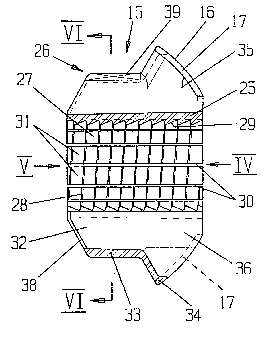Une partie des informations de ce site Web a été fournie par des sources externes. Le gouvernement du Canada n'assume aucune responsabilité concernant la précision, l'actualité ou la fiabilité des informations fournies par les sources externes. Les utilisateurs qui désirent employer cette information devraient consulter directement la source des informations. Le contenu fourni par les sources externes n'est pas assujetti aux exigences sur les langues officielles, la protection des renseignements personnels et l'accessibilité.
L'apparition de différences dans le texte et l'image des Revendications et de l'Abrégé dépend du moment auquel le document est publié. Les textes des Revendications et de l'Abrégé sont affichés :
| (12) Demande de brevet: | (11) CA 2008982 |
|---|---|
| (54) Titre français: | METHODE, ELEMENT D'ANCRAGE ET DISPOSITIF TENDEUR POUR TIGE |
| (54) Titre anglais: | METHOD, ANCHORING ELEMENT AND DEVICE FOR TENSIONING A ROD |
| Statut: | Réputée abandonnée et au-delà du délai pour le rétablissement - en attente de la réponse à l’avis de communication rejetée |
| (51) Classification internationale des brevets (CIB): |
|
|---|---|
| (72) Inventeurs : |
|
| (73) Titulaires : |
|
| (71) Demandeurs : |
|
| (74) Agent: | BERESKIN & PARR LLP/S.E.N.C.R.L.,S.R.L. |
| (74) Co-agent: | |
| (45) Délivré: | |
| (22) Date de dépôt: | 1990-01-31 |
| (41) Mise à la disponibilité du public: | 1990-08-06 |
| Licence disponible: | S.O. |
| Cédé au domaine public: | S.O. |
| (25) Langue des documents déposés: | Anglais |
| Traité de coopération en matière de brevets (PCT): | Non |
|---|
| (30) Données de priorité de la demande: | ||||||
|---|---|---|---|---|---|---|
|
A B S T R A C T
A nut (15), for tensioning a rock-anchor-rod, has a
tubular body (25) with a saw-tooth thread (28). The body
(25) of the nut is divided, by a plurality of longitudinal
slots, into segments (31). The said segments are connected
together by cross-sectionally U-shaped resiliently flexible
ribs (26). One end-face of the nut (15) has a
convex-spherical flange (17) which bears against an
anchor-plate. The slots (30) extend through the flange (17)
as far as the inner wall of the ribs (26). Between the ribs
(26), the flange (17) carries radial incisions (37) extending
as far as the body (25) of the nut. As a result of this the
segments (31) are tangentially resilient. In order to
tension the anchor-rod, the nut (15) is pushed axially onto
the saw-tooth thread of the rod. The jaws of a tensioning
device engage in the thread at the free end of the rod and
bear against the nut (15). When the said cheeks apply
tension to the anchor-rod, the nut (15) is pressed to the
anchor-plate. This ensures rapid and accurate preloading of
the anchor-rod. (Fig. 3).
Note : Les revendications sont présentées dans la langue officielle dans laquelle elles ont été soumises.
Note : Les descriptions sont présentées dans la langue officielle dans laquelle elles ont été soumises.

2024-08-01 : Dans le cadre de la transition vers les Brevets de nouvelle génération (BNG), la base de données sur les brevets canadiens (BDBC) contient désormais un Historique d'événement plus détaillé, qui reproduit le Journal des événements de notre nouvelle solution interne.
Veuillez noter que les événements débutant par « Inactive : » se réfèrent à des événements qui ne sont plus utilisés dans notre nouvelle solution interne.
Pour une meilleure compréhension de l'état de la demande ou brevet qui figure sur cette page, la rubrique Mise en garde , et les descriptions de Brevet , Historique d'événement , Taxes périodiques et Historique des paiements devraient être consultées.
| Description | Date |
|---|---|
| Inactive : CIB de MCD | 2006-03-11 |
| Inactive : CIB de MCD | 2006-03-11 |
| Inactive : Demande ad hoc documentée | 1997-01-31 |
| Inactive : Abandon.-RE+surtaxe impayées-Corr envoyée | 1997-01-31 |
| Demande non rétablie avant l'échéance | 1994-07-31 |
| Le délai pour l'annulation est expiré | 1994-07-31 |
| Inactive : Demande ad hoc documentée | 1994-01-31 |
| Réputée abandonnée - omission de répondre à un avis sur les taxes pour le maintien en état | 1994-01-31 |
| Demande publiée (accessible au public) | 1990-08-06 |
| Date d'abandonnement | Raison | Date de rétablissement |
|---|---|---|
| 1994-01-31 |
Les titulaires actuels et antérieures au dossier sont affichés en ordre alphabétique.
| Titulaires actuels au dossier |
|---|
| H. WEIDMANN AG |
| Titulaires antérieures au dossier |
|---|
| ERWIN ISLER |